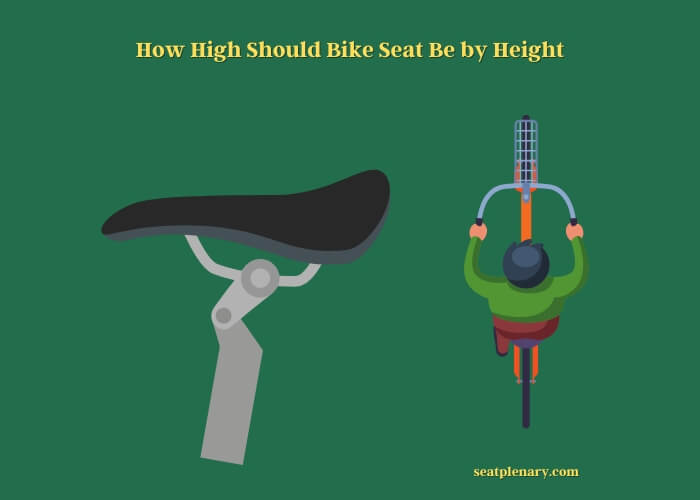The correct height for a bike seat is typically achieved when there is a slight bend in the knee, about 80-90%, at the bottom of the pedal stroke. For a more precise measurement, use a bike seat height calculator which can tailor the dimensions to your individual body measurements.
The interplay between bike seat and handlebars is crucial for comfort and efficiency. As a rule of thumb, when sitting on your saddle, your hands should reach the handlebars without too much bending in your waist or overextension of your arms. The aim is to maintain a posture that is not hunched nor excessively upright.

For children, setting the right bike seat height requires a different approach. The bike seat should be set so that the child can touch the ground with both feet when sitting. This promotes safety, particularly for beginners still gaining their balance.
The 109% method is another strategy used for bike saddle height adjustment. This calculation suggests that your saddle height should be 109% of your inside leg measurement, from the foot to the groin. This method often suits road cyclists, who prefer a high saddle position for better pedal power.
Bike seat height charts can be invaluable tools. These provide a range of suggested saddle heights based on rider’s overall height. For instance, if you’re around 5’4 or 5’5, the charts can help pinpoint the suitable height range. Road bike saddle height calculators also prove beneficial for cyclists who prefer this type of bike, offering more personalized suggestions.
In sum, adjusting your bike seat to the right height can enhance your cycling experience, prevent injuries, and boost performance. By employing these different tools and methods, you can ensure the most comfortable and effective ride.
The Mechanics of Bike Seat Adjustment
Bike seat adjustment plays a pivotal role in enhancing cycling comfort and performance. The first step in the adjustment process involves familiarizing yourself with the bike’s structure, particularly the seat clamp and seat post.
The Seat Clamp is a critical component that allows for upward or downward seat adjustments. It requires loosening to move the seat and tightening afterward to secure the seat in its new position.
The Seat Post, on the other hand, is the part of the bicycle that the saddle is attached to. The length of the seat post determines the range of possible height adjustments.
Making the adjustments requires a specific set of tools, primarily an Allen wrench or a bolt driver, depending on the bike model. To adjust the seat height, loosen the seat clamp, move the seat to the desired position, and then tighten the clamp. Always remember to keep the seat parallel to the ground for optimal comfort and control.
Bike Seat Height Determination: The Methodology
Establishing the correct bike seat height is a blend of science and personal comfort. Several methodologies exist, each with its advantages and considerations.
The Heel-To-Pedal Method is the simplest and most commonly used. This method involves placing your heel on the pedal at its lowest point with your leg fully extended. The ideal height is reached if your leg is straight, without overextending your knee.
The 109% Inseam Method is another scientific approach based on body proportions. It involves measuring the cyclist’s inseam and multiplying it by 1.09. The result is the distance from the top of the saddle to the middle of the bottom bracket.
The Holmes Method is more detailed and takes into account the cyclist’s overall leg length rather than just the inseam. This method is often used by professional cyclists and coaches due to its precision.
Determining the Ideal Bike Seat Height by Rider’s Height
Rider’s height is an essential consideration in establishing the perfect bike seat height. Here’s a rough guide on how to set your bike seat height based on your stature:
Short Riders (5’3″ and Under): For shorter riders, the seat height is usually lower, enabling them to reach the ground easily without overstretching. Remember, comfort is key, and each individual’s body proportion varies.
Average-Height Riders (5’4″ to 5’11”): People of average height have a broader range in which they can adjust their seat height. The heel-to-pedal method or the 109% inseam method could be particularly useful here.
Tall Riders (6’0″ and Above): For taller riders, a higher seat position is often required to provide comfortable leg extension while pedaling. But again, personal comfort and the ability to touch the ground when needed should guide the final setting.
Bike Seat Height for Children
Safety First Approach
For children, bike seat height setting requires a unique approach. The seat should be set at a height where the child can touch the ground with both feet while sitting. This height promotes safety and balance, especially for beginner riders.

Fine-Tuning Your Bike Seat Position
Beyond the seat height, the bike seat’s position relative to the handlebars also influences the cycling experience. Two factors come into play here:
Seat Fore-Aft Position: This is the seat’s position along the bike’s longitudinal axis. Adjusting this affects the weight distribution over the bike and the angle of the body to the handlebars.
Seat Angle: Ideally, the seat should be parallel to the ground. A tilt in either direction could lead to discomfort and inefficient pedaling.
Micro-adjustments in either of these two aspects can make a significant difference in cycling comfort and efficiency. Thus, take time to find the perfect seat position that suits your unique style and needs.
Other Factors Affecting Bike Comfort
Several other elements play a role in ensuring a comfortable bike ride:
| Factors | Description |
| Bike Frame Size | The size of the bike frame must match the rider’s body size for optimal comfort and performance. |
| Geometry | The design of the bike influences how weight is distributed, affecting comfort and handling. |
| Cycling Shoes and Pedals | Proper cycling shoes and pedal types can significantly affect foot comfort and power transfer during cycling. |
| Saddle Tilt | A slight adjustment in the saddle’s tilt can help alleviate pressure and enhance comfort. |
The 109% Method: A Precision Tool
Calculating with 109% Method
This method is named after the rule that the saddle height should be 109% of your inside leg measurement. It’s calculated from the foot to the groin. Multiply your inseam in millimeters by 1.09 to find your seat height in millimeters. This method tends to be preferred by road cyclists who favor a high saddle position for optimal pedal power.
| Leg Measurement (Inseam) | Seat Height (109% of Inseam) |
| 800 mm | 872 mm |
| 850 mm | 926.5 mm |
| 900 mm | 981 mm |
| 950 mm | 1035.5 mm |
| 1000 mm | 1090 mm |
Employing Height Charts
How Charts Help
Bike seat height charts are valuable tools that provide a range of suggested saddle heights based on the rider’s overall height. For instance, a rider who is around 5’4 or 5’5 can use these charts to identify a suitable height range.
Road Bike Saddle Height Calculator
Bike Seat Height Calculator
Personalized Suggestions
Road bike saddle height calculators are beneficial for cyclists who prefer this type of bike. They provide more personalized suggestions, making them a useful tool for road cycling enthusiasts.
The correct seat height can enhance a rider’s cycling experience by increasing comfort, preventing injuries, and improving performance. It’s key for cyclists to use these tools and techniques for the most comfortable and effective ride.
Frequently Asked Questions (FAQs)
What Is the Ideal Bike Seat Height for Someone Who Is 5’4?
There’s no one-size-fits-all answer as it depends on the individual’s inseam. Generally, for someone who is 5’4, the bike seat height could range between 66-70 cm. For an accurate measure, it’s best to use a bike seat height calculator.
Does adjusting the height of a bike seat make it more comfortable for long rides?
Adjusting the height of a bike seat can actually reduce discomfort from bike seats and make long rides more comfortable. Finding the right height can alleviate pressure on the sit bones and reduce strain on the knees, hips, and lower back. Proper positioning is key for a pain-free ride.
Can a Bicycle Saddle Height Calculator Help in Adjusting Seat Height?
Yes, a bicycle saddle height calculator is an effective tool for determining the optimal saddle height. It uses your inseam measurement to provide a precise value for seat height, thereby improving your cycling efficiency and comfort.
How Does a Rider’s Height Affect the Bike Seat Height?
A rider’s height plays a significant role in determining the bike seat height. As a general rule, the taller the rider, the higher the seat needs to be. But it’s also critical to consider leg length or inseam for a more accurate adjustment.
How High Should My Seat Be on My Bike?
The seat on your bike should be high enough that your leg has a slight bend (about 80-90%) when your foot is at the lowest point of the pedal stroke. Using a saddle height calculator can provide a more accurate measure.
Is There a Specific Seat Height for Hybrid Bikes?
Just like other bikes, hybrid bike seat height should allow for a slight bend in the knee at the bottom of the pedal stroke. There isn’t a specific height as it depends on the rider’s inseam. A bike seat height calculator can help determine the appropriate height.
What Is the Bicycle Seat Height Formula?
One popular formula is the 109% method. Here, the saddle height is set at 109% of the rider’s inseam. In practice, you would measure your inseam and multiply it by 1.09 to get the ideal saddle height in millimeters.
How Can a Road Bike Saddle Height Calculator Be Beneficial?
A road bike saddle height calculator is beneficial for providing a more tailored saddle height recommendation. It uses specific parameters like inseam to give cyclists an ideal saddle height, promoting greater efficiency and comfort during rides.
Read more:
